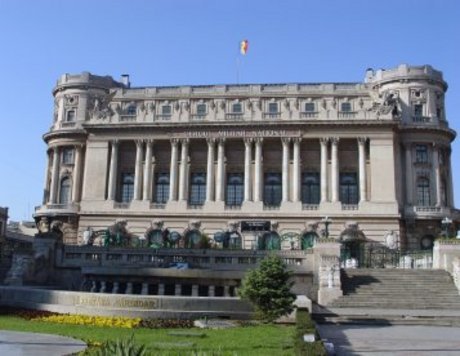The Army Club
The Military Club was build in 1912 on the site of the former Sarindar Monastery (the name witch is preserved in the name of the fontain directly in front of the building). This neoclassic masterpiece, designed by the romanien architect Dimitrie Maimaroiu, was build to host the social, cultural and educational needs of the Romanian army.
This highly ornate building was designed in French neo-Classical style by Dumitru Maimarolu, Victor Stefanescu and Ernest Doneaud. Construction started in 1911 and ended in 1923 with most of the funds being donated by the Romanian Army officers. The Army Club replaced the monastery church of Sarindar which used to sit here. Address: junction of Calea Victoriei/Regina Elisabeta. It is probably one of the first sights in Bucharest every tourist notices after the flight to Romania.
Standing guard imposingly, this neoclassical masterpiece, designed by Romanian architect Dimitrie Maimaroiu, was built in 1912 to serve the social, cultural and educational needs of the Romanian army. Banquets and official events are still hosted in the ballrooms, while the upstairs area is reserved for the army's library, as well as offices and classrooms for officer instruction. The main part of the building is off-limits to civilians, but the sumptuous restaurant and summer terrace is open to the public.
Like mentioned in its original statutory documents, The Military Club it is a place where the employees of the military force could spend quality time in different cultural, artistic, creative activities and also enriching their experience with professional reorientation and self development courses. The Club didn’t have its headquarters here from the begining. The necessary funds for building this piece of fine architecture which still impresses the people passing nearby, have been raised up to 80% from the voluntary contributions of the members (all army employees).
The construction started in 1911 and it took 12 agitated years (with all negative the implications of the First World War) to achieve it. It was finally inaugurated by King Ferdinand at 4th February 1923. The main architect was the Romanian Dimitrie Maimarolu, with the collaboration of Anghel Saligny and French architect Ernest Doneaud. It has 10 big halls: The Marble Hall, Moresque Hall, Byzantine Hall, Gothic Hall, Norwegian Hall, Performance Hall, Cinema Hall, Gallery of Arts, Mirrors Hall, Heroes Hall.




